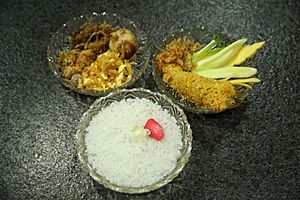Khao chae facts for kids

Khao chae as served in Bangkok, Thailand.
|
|
| Place of origin | Central Thailand (adapted from the original Mon recipe) |
|---|---|
| Similar dishes | Thingyan rice |
Khao chae (pronounced "cow chay") is a special Thai dish that means "rice soaked in cool water." It's a refreshing meal, perfect for hot weather. The word "Khao" means rice, and "chae" means to soak. This dish is usually enjoyed during Thailand's hottest time of the year, from mid-March to the end of April. Long ago, when ice wasn't common in Thailand, people kept the water cool by storing it in clay pots in shady spots. Some old recipes even used a special type of camphor to help cool the dish.
Contents
The Royal History of Khao Chae
Khao chae has a fascinating history! It originally came from the Mon people, who live in parts of Myanmar and Thailand. They prepare a similar dish called Thingyan rice during their New Year festival, called Songkran (or Thingyan).
When Khao chae was first brought to Thailand, during the time of King Rama II (who ruled from 1809 to 1824), it became a very special meal. It was considered "royal cuisine," meaning only the king and his family or people in the palace could eat it. It wasn't something ordinary people could buy or make. A famous Thai chef, McDang, who grew up in a Bangkok palace, even said it's the only dish that truly feels like "royal Thai cuisine."
Today, you can find Khao chae in many places. Some of the most famous spots in Bangkok to try it are in neighborhoods like Banglampoo and near the Democracy Monument. These areas are in the Phra Nakhon district.
How to Make Khao Chae
Making Khao chae is a bit tricky and takes a lot of care. It's not just about soaking rice in water! Here's how it's usually prepared:
Choosing and Preparing the Rice
You can't use just any rice for Khao chae. Regular jasmine rice is too soft. Instead, a firmer kind called khao taa haeng is used. First, this rice is cooked normally. Then, it's put into a colander and rinsed many times under running water. This step is important because it removes extra starch, making the rice grains separate and firm.
Making Scented Water
This is where the magic happens! The water for Khao chae is specially scented with flowers.
- A large pot is filled halfway with water.
- A handful of fresh jasmine blossoms are added.
- Then, a small, flower-scented candle is floated on top and lit.
- The pot is loosely covered for about 15 minutes.
- This process is repeated two more times, sometimes with different scented candles.
The goal is for the lovely smell from the candles and the natural oils from the jasmine flowers to fill the water.
Preparing the Rice for Serving
Once the rice is cooked and the water is scented, the rice is sprinkled with the fragrant water. It's then wrapped tightly in a piece of cheesecloth. This bundle is steamed over boiling water. This helps the rice absorb the scent without becoming mushy.
To serve, some of the special rice is placed in a bowl. Then, more of the fragrant water is poured over it. A few small ice cubes are added to keep it cool, along with a few fresh flower petals for decoration and extra scent.
Delicious Side Dishes
While the rice and scented water are important, the side dishes are truly the stars of a Khao chae meal. They add amazing flavors and textures. Recipes for these sides can be different, but some essential ones are always there.
Here are some common side dishes you might find with Khao chae:
- Kapi balls (ลูกกะปิ: luk kapi): These are small, flavorful balls made from shrimp paste. The paste is mixed with wild ginger, shallots, garlic, and palm sugar. This mix is cooked until it becomes a thick, fragrant paste. Once it cools, it's rolled into tiny balls.
- Stuffed shallots (หอมแดงยัดไส้: hom daeng yat sai): These are small Thai onions (shallots) filled with ground fish, herbs, spices, fish sauce, and palm sugar. After being stuffed, they are dipped in a light batter and fried until golden.
- Stuffed sweet peppers (พริกหยวกสอดไส้: prik yuak sot sai): Sweet peppers are stuffed with herbs, spices, and ground pork. They are first steamed, then cooled, and finally deep-fried. Sometimes, they are wrapped in a delicate, lacy egg crepe.
- Shredded sweetened beef or pork (หมูฝอย: mu foi or เนื้อฝอย: nuea foi): This dish uses either beef or pork, depending on what you prefer. The meat is torn into thin strands and seasoned with palm sugar and fish sauce. It's then dried and deep-fried until it's crispy and sweet.
- Stir-fried sweet pickled Chinese turnips with eggs (ไชโป๊ผัดไข่ chaipo phat khai): This is a simple but tasty stir-fry made with sweet pickled turnips and scrambled eggs.
- Fresh vegetables and herbs: To balance the rich and sweet side dishes, fresh ingredients are always served. These include raw mango, fresh cucumber, fresh wild ginger, fresh chilies, and fresh spring onions. They add a refreshing crunch and help with digestion.

